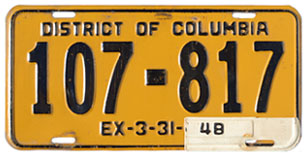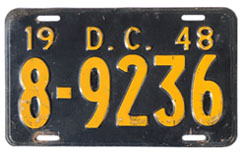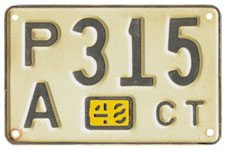Changes Made, Not Made to D.C. License Plates for 1948
 |
 |
1947 April 1947-March 1948 |
1948 April 1948-March 1949 |
Decisions about District of Columbia 1948 license plates were made during April and early May 1947, and although detailed information about the many changes made compared to 1947 and earlier plates is not at hand we know that other changes were suggested but not adopted, and that the final design was a compromise among various interests.
Early 1947 appears to be when Minnesota Mining & Manufacturing Co. (now 3M Corp.) first had a viable, marketable reflective sheeting product to offer to the states for use on their license plates and traffic signs.  Connecticut was the first state to adopt the new technology for plates, and it was a natural candidate for such a role because by 1947 it had already used small, multi-year baseplates validated with tabs for 10 years. The adoption by states of relatively small, semi-permanent plates made from aluminum and covered with reflective sheeting appears to have been the subject of lobbying by 3M in early 1947 because the Commissioners' Traffic Advisory Board in D.C. recommended at that time that such a plate be approved for 1948. Although this proposal failed here it succeeded in Connecticut, resulting in the nation's first auto plates with a fully reflective background.
Connecticut was the first state to adopt the new technology for plates, and it was a natural candidate for such a role because by 1947 it had already used small, multi-year baseplates validated with tabs for 10 years. The adoption by states of relatively small, semi-permanent plates made from aluminum and covered with reflective sheeting appears to have been the subject of lobbying by 3M in early 1947 because the Commissioners' Traffic Advisory Board in D.C. recommended at that time that such a plate be approved for 1948. Although this proposal failed here it succeeded in Connecticut, resulting in the nation's first auto plates with a fully reflective background.
3M has, apparently since at least early 1947, engaged in lobbying of state officials and lawmakers in order to promote its often innovative traffic marking and control products. A group such as the D.C. Traffic Advisory Board presumably did not have the expertise and capacity to investigate alternatives grounded in emerging technologies to embossed, painted steel license plates that by the late 1940s had been the standard nationwide for 30 years, but they would have an obligation to consider viable alternatives of which they were aware that might improve public safety. Undoubtedly 3M was the most qualified institution to bring such alternatives to the attention of rule-making bodies coast to coast, and the Traffic Advisory Board apparently liked what they heard enough to propose to the commissioners that they make dramatic changes to D.C. license plates for 1948.
Proposed Changes Adopted Include New Size, Numbering Format
Changes made to the plate size and numbering format for 1948 likely did not result directly from the Traffic Advisory Board's endorsement of reflective plates, although with aluminum then (and now) being substantially more expensive than steel the size reduction may have been suggested as a partial offset to the anticipated higher plate cost. In fact, it appears that the size change likely was made primarily to save money on raw materials as well as to hedge against the risk that steel supplies might be limited. At the time, steel used in plate production was obtained in large sheets, not rolls as is the custom today. In a May 14, 1947, memo in which Director of Vehicles and Traffic George E. Keneipp summarized plate-related decisions made at a May 1 meeting of the commissioners, he indicates that “only 14 pairs of plates can be obtained from a 30" x 96" sheet of 24-gauge steel, whereas 24 pairs of the 6" x 10" tag can be obtained from each sheet thus leaving no waste. A larger size tag would necessitate an additional order for approximately 5,500 sheets (110,000 pounds) of steel.”
The numbering format introduced for 1948, which provides for all plates to have a registration number comprised of five or fewer characters, is described on our page dedicated to 1940s plates. The method of marking plates with the registration year shifted from the expiration date to the issuance year, so that plates marked "EX-3-31-48" were replaced by smaller plates marked "1948." Although documents that describe the reason for this change have not been found, one memo about 1948 plates indicates that “The Corporation Counsel advises that there is no legal reason why the actual expiration date of the tags need be indicated.”
Proposed Changes Rejected: “Untidy-Appearing District Tags” are Undesirable
Without evidence to the contrary, extant documentation leads us to conclude that the Commissioners' Traffic Advisory Board was substantially influenced by representatives of 3M and/or lobbyists engaged on their behalf, and representatives of aluminum producers likely also were involved in an effort to have aluminum plates issued in D.C. for 1948. The Board appears to have proposed that multi-year aluminum plates covered with reflective sheeting and validated annually with tabs be issued, but that an alternative would be to issue natural aluminum plates (i.e. bare aluminum plates with only the embossed areas painted), or simply to substitute aluminum for steel in the manufacture of embossed, painted plates. Aluminum license plates, both natural and painted, were introduced in a number of states in the late 1940s, and this likely was not a coincidence but rather the result of effective business development initiatives by the aluminum industry.
In his May 14 memo in which he documents decisions made by the commissioners two weeks earlier, Mr. Keneipp summarized his aversion to validation tabs, then in use on 1946 (EX-3-31-47) baseplates for the 1947 registration year, by stating that “experience in this and previous registration years has proven that the use of tabs is undesirable for the following reasons:
-
Increased administrative costs. Not only does it slow up tag issuance, but extra operation of cutting the old tag number on the new tag application requires full time from eight to ten extra clerks during the tag rush period;
-
Serial numbers are difficult to read;
-
Theft of tabs is relatively easy and many such thefts have occurred;
-
They are easily lost in transit;
-
Car owners apply them in various places on the large plates, making for a very untidy-appearing District tag.”
The high cost of aluminum compared to steel was cited, even if the plates were used for the proposed five-year period. “Estimates which have been supplied by the Department of Corrections indicate that aluminum plates, .051 gauge (which is similar to that used by states which have adopted permanent aluminum tags), would cost $.335 per pair with a coating of black enamel and raised chrome yellow figures and letters, or a total of $71,950 for the 170,000 pairs of plates which will be required for next year. In its budget estimates for FY 1948, the Department of Vehicles and Traffic has included but $20,000 for the manufacture of tags.” “Over a five-year period, assuming present costs remain the same and contemplating the issuance of an original pair of 6" x 10" plates, plus a pair of tabs each year thereafter (cost $.07 per pair), it is doubtful if there would be any saving to the District. On the basis of 170,000 pairs of tags the first year, 15,000 pairs for each of the four succeeding years for replacements and additions, 180,000 pairs of tabs in the second year, 190,000 pairs of tabs in the third year, and 200,000 pairs of tabs in each of the fourth and fifth years, there would be an estimated saving of about $3,600 per year. But it is feared that rising costs, plus the need for manufacturing a greater quantity of the large plates than estimated for replacement might absorb the entire saving.”
Plain aluminum plates were also considered undesirable due to plates of the same style, black on natural aluminum, then being in use or planned for issuance in neighboring states. "Should the District adopt a similar plate,” wrote Mr. Keneipp, “there would be but little difference in the appearance of Maryland, Virginia, and District of Columbia plates. Hence, ready identification would be difficult.” Reflectorization was not considered a viable option due to the cost, $.29 per pair of plates, and that the material was new and untested.
The president of the Board of Commissioners formally suggested that plates painted red, white, and blue, similar to those then in use by the federal government, be issued in the District for 1948. After debate by the commissioners and other officials it was determined that this proposal would not be approved due to the high cost of tri-color plates ($.275 per pair as opposed to $.15 for two-color plates) and that they would blend in with federal plates, among other reasons.
Following late April 1947 publicity of preliminary plans for 1948 plates, a suggestion was received that DISTRICT OF COLUMBIA continue to be used instead of the planned "D.C." The commissioners apparently agreed with Mr. Keneipp, who wrote that the abbreviated form “is more readily identifiable than the longer designation.” It is more likely that "D.C." was used simply because it was easier to fit on the relatively small plates planned for 1948.
As part of the new numbering system that provided for plates of most non-passenger types to be marked by a letter prefix rather than the type name being displayed, the State Department responded negatively to the proposal that Diplomatic plates be marked only with a letter A prefix. In response, the diagonal DPL designation was introduced and A-prefix numbers were released for private passenger use whereas the first letter to appear on auto plates would otherwise have been E.
Early 1947 is the first instance that we have found in which a representative of the Medical Society of the District of Columbia suggested that plates with an MD prefix be made available exclusively to physicians. This proposal was not approved, the commissioners being “opposed to the idea of creating special designations for special groups because of the precedent which it might establish.” However, MD-series plates were indeed set aside for physicians beginning sometime between 1960 and 1964 (as discussed here).
|
This page last updated on December 31, 2017 |
 |
|
copyright 2006-2018 Eastern Seaboard Press Information and images on this Web site may not be copied or reproduced in any manner without consent of the owner. For information, send an e-mail to admin@DCplates.net |














